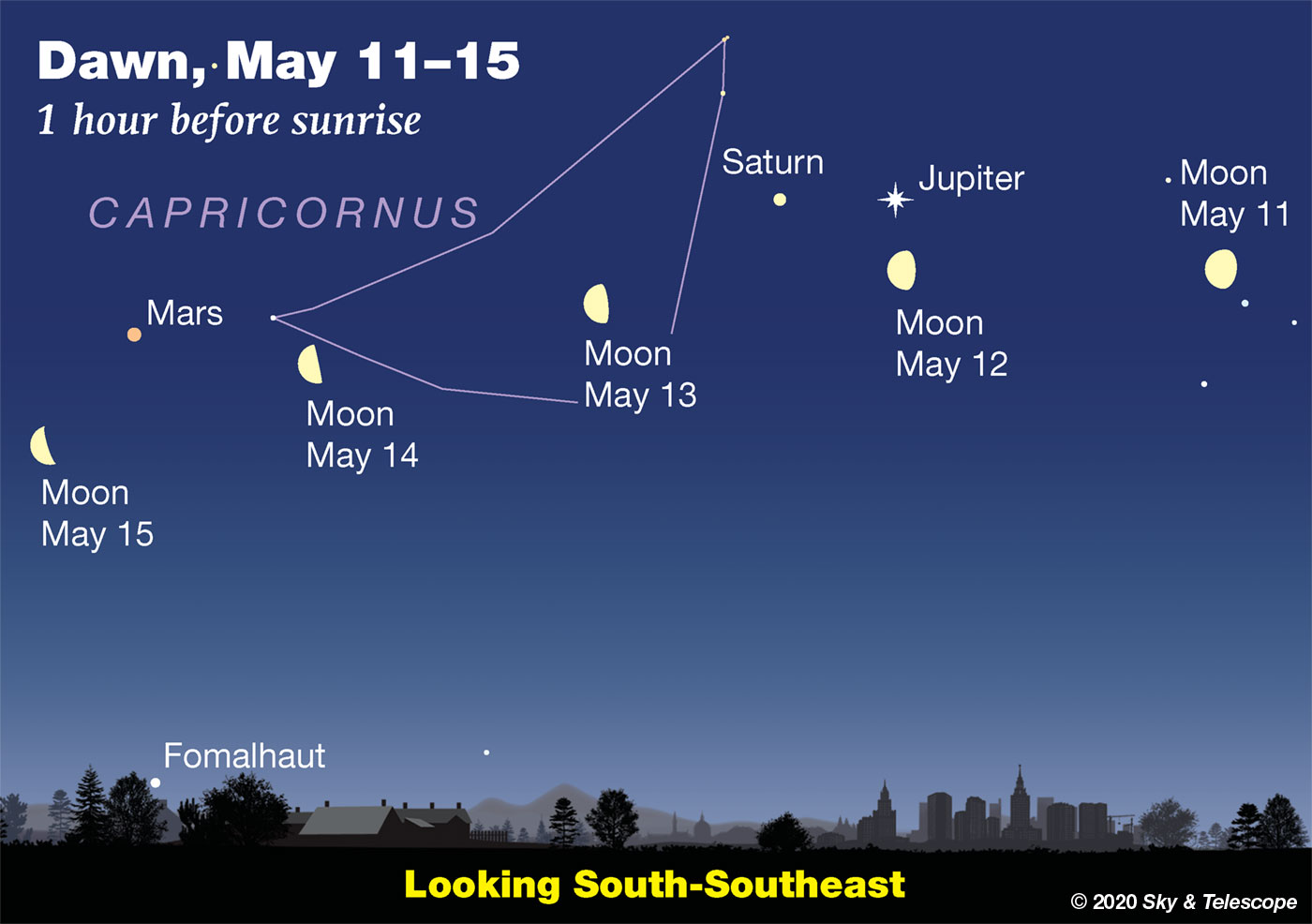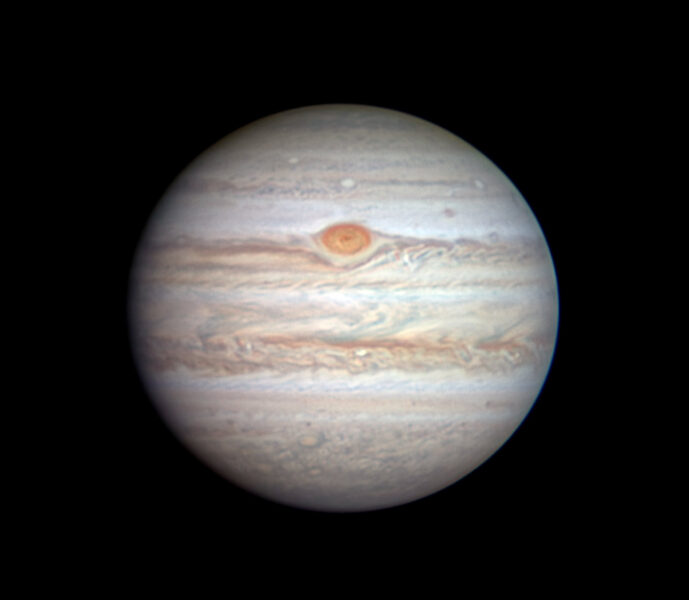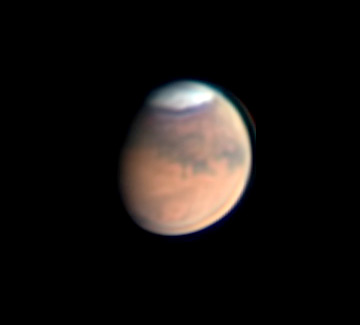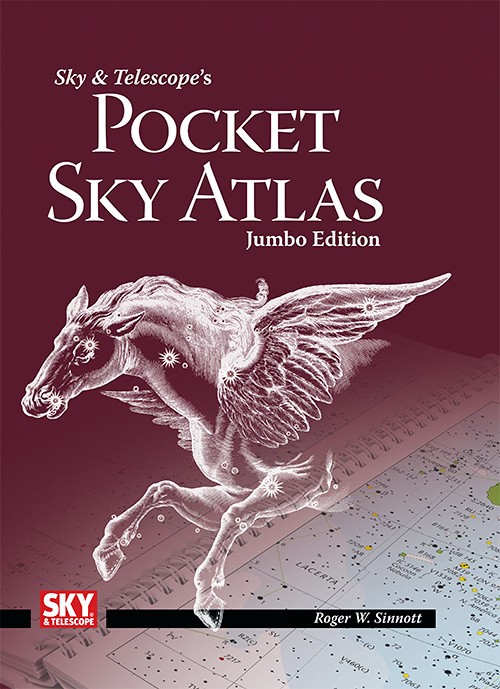Comet SWAN punking out? (Updated May 13.) Comet SWAN (C/2020 F8), now low above the pre-dawn horizon for mid-northern observers, has stalled out at about magnitude 5.5 rather than brightening to 3rd as hoped. It's low above the pre-dawn northeast horizon (for observers at mid-northern latitudes) this week and next, then its best visibility will shift to low above the northwest horizon right after dusk as it approaches its May 27th perihelion. In other words, low and tricky to find! It crosses Perseus for the rest of May. See Bob King's Comet SWAN charts. You'll need big binoculars or a telescope.
Supernova in Leo, magnitude 12.4. (Updated May 13.) A supernova in visual range of 6-inch scopes has erupted in NGC 3643 south of the hind foot of Leo, high after dark. As of May 12th, SN 2020hvf was about magnitude 12.4 and easily outshining its host galaxy. Meanwhile, a deeper challenge is 14.4-magnitude SN 2020jfo in M61 in Virgo, also high these evenings. See Supernovae Light Up in M61 and NGC 3643.
Friday, May 8
■ All week, look high in the west at nightfall for Pollux and Castor, the heads of the Gemini twins. They're lined up almost horizontally (depending on your latitude), some 30° upper left of brilliant Venus: about three fists at arm's length.
Pollux and Castor form the top of the enormous Arch of Spring. To their lower left is Procyon, the left end of the Arch. Farther to their lower right is the other end, formed by Menkalinan (Beta Aurigae) and then brilliant Capella.
Venus shines below the Arch's right side.
■ The waning gibbous Moon rises in the east-southeast tonight around 10 p.m. daylight-saving time, depending on where you live in your time zone. Once it's well up, look to its right or lower right for Antares, twinkling pale orange. Around and to the upper right of Antares are lesser, whiter stars of Scorpius.
Saturday, May 9
■ The Summer Triangle is making its appearance in the east, one star after another. The first in view is bright Vega. It's already visible in the northeast as twilight fades.
Next up is Deneb, lower left of Vega by two or three fists at arm's length. Deneb takes about an hour to appear after Vega does, depending on your latitude.
The third is Altair, which shows up far to their lower right by midnight.
■ Asteroid to occult a star. David Dunham of the International Occultation Timing Association writes us, "Occultation of 9.5-magnitude SAO 82820 by (667) Denise [along a track from] northern Mid-Atlantic (clear skies forecast there) to southern Oregon, night of Saturday May 9/10; see page for this event. The path passes over Washington, DC (4:54 UT May 10 UT); Columbus & Dayton, OH (4:55 UT); Indianapolis and Urbana, IL (4:56 UT); Des Moines and Omaha (4:57 UT); and Pocatello and Twin Falls, Idaho (5:00 UT)."
Sunday, May 10
■ Three zero-magnitude stars shine after dark in May: Arcturus high in the southeast, Vega much lower in the northeast, and Capella in the northwest (upper right of Venus). They appear so bright because each is at least 60 times as luminous as the Sun, and because they're all relatively nearby: 37, 25, and 42 light-years away, respectively.
■ Another asteroid occultation. David Dunham writes, "Occultation of 5.7-magnitude 14 Cancri by (363) Padua for the southwestern US Sunday evening, May 10/11; see the IOTA page for the event, with a lot of observing advice."
■ Before dawn on Monday the 11th, the waning gibbous Moon shines in the south. Left of it are Jupiter and Saturn, as shown below.
Look closer below the Moon for the handle of the Sagittarius Teapot. The handle's three brightest stars show at far right in the scene below.

Monday, May 11
■ Before and during early dawn on Tuesday the 12th, the waning gibbous Moon shines under Jupiter and Saturn as shown above. For skywatchers in North America's Central and Mountain time zones, they'll form a virtually perfect right triangle while dawn is brightening.
Tuesday, May 12
■ Vega is well up in the east-northeast as evening advances. Look for its faint little constellation Lyra, the Lyre, hanging down from Vega with its two-star bottom canted a bit to the right.
■ Take advantage of these moonless evenings to work through a fine clutch of galaxies in the northern reaches of the Virgo Cluster high overhead, using the Deep-Sky Wonders article and charts in the May Sky & Telescope, page 54. The five selections there range from magnitude 9.6 to 12.8.
Wednesday, May 13
■ This is the time of year when Leo the Lion starts walking downward toward the west, on his way to departing into the sunset in early summer. Right after dark, spot the brightest star fairly high in the west-southwest. That's Regulus, his forefoot.
■ Before and during early dawn Thursday and Friday, the waning Moon accompanies Mars as shown above.
Thursday, May 14
■ A gigantic asterism you may not know about is the Diamond of Virgo, some 50° tall and extending over five constellations. It now stands upright in the south after dark. Start with Spica, its bottom. Upper left from Spica is bright Arcturus. Almost as far upper right from Arcturus is fainter Cor Caroli, 3rd magnitude. The same distance lower right from there is Denebola, the 2nd-magnitude tail-tip of Leo. And then back to Spica.
The bottom three of these stars, the brightest, form a nearly perfect equilateral triangle. Maybe we should call this the "Spring Triangle" to parallel those of summer and winter?
■ Last-quarter Moon (exact at 10:03 a.m. Eastern Daylight Time). Tonight the Moon rises very late, around 3 a.m. Friday morning daylight-saving time, by which time it will be visibly a little past first quarter, as shown above. And Mars will be upper right of it.
Friday, May 15
■ A naked-eye Venus challenge! All week, the large, thin crescent shape of Venus is easy to discern with even a very small telescope or good, steadily braced binoculars. But can you resolve its crescent with your unaided eyes? Mere 20/20 vision isn't good enough; success may await the eagle-eyed with 20/15, 20/12, 0r (rare) 20/10 vision. Try during different stages of twilight before the sky is too dark and Venus's glare becomes overwhelming. Look long and carefully and report your results to Sky & Telescope's Bob King, [email protected], as told in the May issue, page 49.
You may improve your chances by sighting through a clean, round hole in a stiff piece of paper 1 mm or 2 mm in diameter (try both). This will mask out optical aberrations that are common away from the center of your eye's cornea and lens.
One person who apparently succeeded was Edgar Allan Poe. An amateur astronomer since boyhood, he used a naked-eye sighting of Venus's crescent as the central event in his poem "Ulalume" (1847). Before dawn, a bereaved lover roams an October woodland "with Psyche, my soul." Ahead of them low in the east, where Leo always ascends in mid-autumn, they witness the new-risen Venus, star of romantic love in Roman mythology, coming "up through the lair of the Lion." Poe refers to the planet as Astarte, the wilder, more wanton Greek version of the Roman Venus-goddess:
At the end of our path a liquescent
And nebulous lustre was born,
Out of which a miraculous crescent
Arose with a duplicate horn—
Astarte's bediamonded crescent
Distinct with its duplicate horn.
Poe compares its passionate brilliance to cooler, less dazzling Dian, the horned crescent Moon, and urges Psyche forward:
Let us on by this tremulous light!
Let us bathe in this crystalline light!
But Psyche, who knows better, is terrified, and this being Poe, it doesn't end well.

Poe wrote "Ulalume" in the fall of 1847. Before dawn on November 4, 1847, a crescent Venus and crescent Moon ("Dian") indeed hung near each other low in the east below Leo – perhaps in Poe's "lair of the Lion," the sky area from which the traditional Leo figure stalks away.
Venus was also there in the mid- and late "lonesome October" of that year as a larger, thinner crescent, but the Moon was not.
Saturday, May 16
■ These dark spring evenings, the long, dim sea serpent Hydra snakes level far across the southern sky. Find his head, a rather dim asterism about the width of your thumb at arm's length, in the southwest. It's upper right of Procyon, the brightest star due west, by about a fist and a half. The brightest star of Hydra is Alphard, his 2nd-magnitude orange heart, a fist and a half left of his head.
Hydra's tail stretches all the way to Libra rising in the southeast. Dim Crater and brighter Corvus ride on his back. Hydra's star pattern, from forehead to tail-tip, is 95° from end to end, longer than any other constellation.
This Week's Planet Roundup
Mercury begins to creep up into evening twilight late this week. Start looking for it around May 13th, very low in the west-northwest 20 or 30 minutes after sunset. It's roughly 15° lower right of Venus. Binoculars help. At least Mercury is brighter than usual at magnitude –1.2. It gets a little higher and easier each evening. Mercury will pair up with Venus on May 21st, when they'll be 1° apart.
Venus (magnitude –4.7, in northern Taurus) is the bright white "Evening Star" in the west during and after dusk. It's still at its brightest but is moving lower day by day.
Look upper right of Venus for Capella, almost two fists at arm's length (18°) away. Much closer above Venus is Beta Tauri (El Nath), fainter at magnitude 1.6. They're within 2° of each other all week.

Mars, Jupiter, and Saturn (magnitudes, +0.3, – 2.4, and +0.5, respectively) shine in the southeast to south before and during early dawn.
Jupiter, the brightest, is on the right. Before dawn begins, spot the Sagittarius Teapot to the right of it.
Saturn glows pale yellow 4° to Jupiter's left. To me they look like an unequal pair of eyes in the dawn.
Mars is much farther (25° or 30°) to Saturn's left or lower left. In a telescope Mars has grown to 8 arcseconds wide: no longer a tiny blob but a little gibbous disk. Mars is on its way to an excellent opposition in early October, when it will reach an apparent diameter of 22.6 arcseconds.

Uranus is hidden low in the glow of dawn.
Neptune (magnitude 7.9, in Aquarius) is fairly low in the east-southeast just before dawn begins.
All descriptions that relate to your horizon — including the words up, down, right, and left — are written for the world's mid-northern latitudes. Descriptions that also depend on longitude (mainly Moon positions) are for North America.
Eastern Daylight Time (EDT) is Universal Time (UT, UTC, GMT, or Z time) minus 4 hours.
Want to become a better astronomer? Learn your way around the constellations. They're the key to locating everything fainter and deeper to hunt with binoculars or a telescope.
This is an outdoor nature hobby. For an easy-to-use constellation guide covering the whole evening sky, use the big monthly map in the center of each issue of Sky & Telescope, the essential guide to astronomy.

Once you get a telescope, to put it to good use you'll need a detailed, large-scale sky atlas (set of charts). The basic standard is the Pocket Sky Atlas (in either the original or Jumbo Edition), which shows stars to magnitude 7.6.
Next up is the larger and deeper Sky Atlas 2000.0, plotting stars to magnitude 8.5; nearly three times as many. The next up, once you know your way around, are the even larger Interstellarum atlas (stars to magnitude 9.5) and Uranometria 2000.0 (stars to magnitude 9.75). And read how to use sky charts with a telescope.
You'll also want a good deep-sky guidebook, such as Sky Atlas 2000.0 Companion by Strong and Sinnott, or the bigger Night Sky Observer's Guide by Kepple and Sanner.
Can a computerized telescope replace charts? Not for beginners, I don't think, and not on mounts and tripods that are less than top-quality mechanically (meaning heavy and expensive). And as Terence Dickinson and Alan Dyer say in their Backyard Astronomer's Guide, "A full appreciation of the universe cannot come without developing the skills to find things in the sky and understanding how the sky works. This knowledge comes only by spending time under the stars with star maps in hand."
![]() Audio sky tour. Out under the evening sky with your earbuds in place, listen to Kelly Beatty's monthly podcast tour of the heavens above. It's free.
Audio sky tour. Out under the evening sky with your earbuds in place, listen to Kelly Beatty's monthly podcast tour of the heavens above. It's free.
 5
5








Comments
Rod
May 11, 2020 at 8:19 am
mary beth, hope you enjoyed Mother's Day yesterday 🙂 I was out and about on my mountain bike and using my binoculars looking at osprey and ducks. In the evening, clear and cool skies, temp 10C. From 2000-2330 EDT, I enjoyed views of globular clusters and galaxies using my 10-inch telescope and comparing to the 90-mm refractor. M3, M53, M86, M87, M104 very nice view in the 10-inch. Waning gibbous Moon rise near 2359 EDT so in the early evening, clear and no moon. I could see all the stars of Corona Borealis including Eta Coronae Borealis at mv+5.6 or so with unaided eyes. Some Starlink polar orbiting satellites passed by, two in parallel paths moving south and another heading up or ascending node. One faint meteor streaked by to the west too. A great time outdoors :)--Rod
You must be logged in to post a comment.
mary beth
May 12, 2020 at 9:56 am
My goodness. You had a fruitful day and night! Sure was a lot of motion in the night sky with three satellites and the meteor. That must’ve been exciting to see the entire Corona Borealis. I can barely see Alphecca here in Houston. (Move delayed due to COVID ). Won’t be long until we were all looking at Scorpius in the evening! Continue to enjoy and report! Quick question can you see all of Corvus?
You must be logged in to post a comment.
Rod
May 12, 2020 at 9:45 pm
Yes to Corvus. No problem. It straddles about 30 degrees altitude at my location, especially as Corvus approaches transit or the meridian. Today was an enjoyable time outdoors. Pasture mowing and splitting logs and stacking wood for the coming winter. More trees cut down that were getting old and dying. Some white oaks that I will reuse later in my outdoor fires and wood burning stove. No stargazing tonight, just relax after lifting, splitting, and moving cut logs all around in the fields 🙂
You must be logged in to post a comment.
Rod
May 13, 2020 at 9:08 am
mary beth, you may like this observation note. I did view comet SWAN early this morning in MD. Clear sky and temperature 4C with light NW winds. I was out with binoculars and my 90-mm refractor telescope. More detail at Bob King's page report on SWAN--Rod
[Observed 0400-0600 EDT. Sunrise 0556 EDT. The big event targets this morning was the Io shadow transit at Jupiter and 10x50 binocular observation of comet SWAN C/2020 F8. I could just barely see the comet in ENE sky from 0450-0500 EDT, close to 10 degrees altitude or elevation above the horizon. The comet ascended near 0403 EDT or 0803 UT. It had a short, small tail but faint because the horizon, brightening as sunrise approached near 0556 EDT...Jupiter is putting on the show now in the telescope view. I enjoyed at 129x and 200x views...Io tiny shadow started moving across the disk of Jupiter and distinct, easy to see near 0500 EDT or 0900 UT. Io shadow transit ingress this morning at 0853 UT or 0453 EDT. The three Galilean moons Ganymede, Callisto and Europa were in a tight triangle as Io shadow transit took place. Numerous cloud bands visible on Jupiter and size a bit more than 42"...This was a great morning out before sunrise and when I came back in, a large skunk was in the yard greeting me on the south side. I stopped and we just stared at each other for a bit, then the skunk scurried off to the woods by the horse barn. A very enjoyable way to greet the sunrise this morning with comet SWAN, Io shadow transit, Saturn, Mars, and waning gibbous Moon views using the telescope. Saturn began retrograde on 11-May-2020, Jupiter begins retrograde 14-May-2020.]
You must be logged in to post a comment.
mary beth
May 13, 2020 at 10:53 am
I think your skunk friend wanted to use your telescope to see the comet! Sounds like a very nice morning, full of all the best of God’s creation..stars, sun and creatures! I haven’t read Bob King’s article yet but I read another article that statedthe comet’s magnitude will peak on May 27 or so? If so I hope you have a few more good viewings and especially one on the morning of peak brightness. I’ll read Bob’s article right now.
You must be logged in to post a comment.
You must be logged in to post a comment.